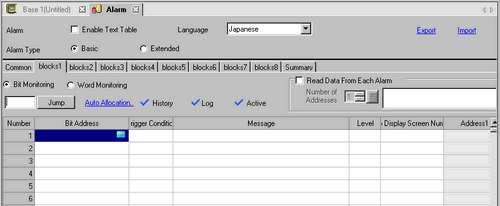
Configure settings to trigger the Alarm by monitoring a bit's ON/OFF state.

Bit Monitoring
The alarm is triggered when the monitoring bit address turns ON (OFF).
Jump
Go to a specific row number.
Auto Allocation
The [Address Auto Allocation] dialog box appears. Configure settings to allocate addresses from the [Start Address] by specified increments.
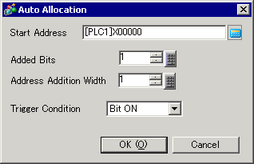

When a previous address exists, it will be overwritten.
Start Address
Set the Bit Address that will start the Auto Allocation.
Added Bits
Set the number of Bit Addresses (from 1 to Alarm limit - Current row position + 1) for Auto Allocation.
Increase Address By
Set the number of bits to add during an Auto Allocation, from 0 to 4096.
Trigger Condition
Sets up if the alarm is triggered when the monitoring bit address turns ON or when the monitoring bit address turns OFF.
History/Log/Active
Displays current display mode set in the [Common] tab.
Number of Units
Set the number of units. Depending on the specified number of units, a rung for setting the Monitoring Address will be added. You can specify separate Monitoring Addresses for multiple units of the same message. A maximum of 256 units can be set for each block.
Polling Frequency
Set the Polling Frequency for reading the Alarm Monitoring Device.

When a read operation is started, read requests for the same block are not accepted until all devices have been read.
If the state of the Monitoring Device changes during a read operation, it will be read during the following polling frequency.
If there is a read request from a separate block during a read operation, the block with the earliest request will be read starting immediately before the current read operation is completed.
The Polling Frequency's actual value (in seconds) and the average value (in seconds) are stored, block by block, in the following internal device addresses. Also, if the actual value exceeds the defined polling frequency even once, the defined range frequency exceeded bit is set ON. Once the bit is set ON, it will not turn OFF, even if the actual values goes under the polling frequency. You need to turn the bit OFF manually.
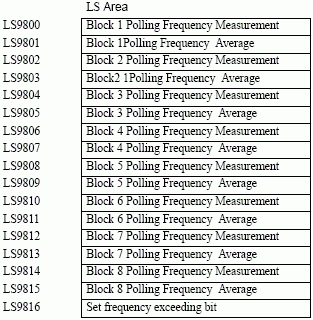
The format for the set frequency exceeding bit is as follows.
|
LS9816 |
Bit |
Introduction |
|
0 |
Block 0 Exceeding Bit | |
|
1 |
Block 1 Exceeding Bit | |
|
2 |
Block 2 Exceeding Bit | |
|
3 |
Block 3 Exceeding Bit | |
|
4 |
Block 4 Exceeding Bit | |
|
5 |
Block 5 Exceeding Bit | |
|
6 |
Block 6 Exceeding Bit | |
|
7 |
Block 7 Exceeding Bit | |
|
8 to 15 |
Reserved |
Read Data From Each Alarm
Specifies whether or not Alarm message data is read.

Number of Addresses
Read data values from 1 to 8. Adds the [Common Address] setting rows to the set number of addresses. The address setting column will be available for input in the Alarm List.
Use Same Address
Sets whether or not address data values are read in all the messages in the block regardless of the Alarm Message. In the address setting column, you cannot set anything from the second row onward.
Number
Displays the Alarm Message registration number (Row Number) from 1 to 2048.

For Alarm Messages, up to 2048 Monitor Bits and Monitor Words can be registered but the maximum number of Alarms that can be stored by the display unit for the whole Alarm History is 768.
When IPC Series is selected, a maximum of 10000 alarm messages can be registered in the alarm history.
If you install a GP3000 Function Expansion Memory, and from the [Common Settings] menu select [Alarm] to set the [Alarm Type] option to [Extended], you can register up to 32767 alarm messages.
Unit Name
Rows are inserted according to the number of units specified in [Number of Units]. Unit names can be up to 32 single-byte characters. You can also use data from the Text Table. When an alarm occurs, the Unit Name + Message is displayed as the Alarm Message.

When using the Text Table data, if line feed is inserted in the data, the text before the line feed will be displayed as a unit name. The text after the line feed will not be displayed.
Bit Address
Set the Bit Address to monitor the alarm trigger.

Please ensure that the total of [Monitoring Bit Address] and [Monitoring Word Address] for the whole Alarm History (Block 1 to Block 8) are within 256 words.
Trigger Condition
Sets up if the alarm is triggered when the monitoring bit address turns ON or when the monitoring bit address turns OFF.
Message
Set an alarm message within 160 single-byte characters.

When [Enable Text Table] is not selected, you can insert up to 5 lines by typing [Alt]+[Enter].
When [Enable Text Table] is selected, this displays with the text table's number of index characters. If [Multiple line display] is selected from [Show History] - [Message Display Method] for the Alarm part, up to 5 lines of alarm messages can be displayed; however, if the text longer than 5 lines is set, only up to 5 lines will be displayed.
If an alarm part is set to [Show History] with the [Message Display Method] set to [1 Line display], and the message uses text table data which uses line feeds, only text before the line feed displays as the message. The text after the line feed will not be displayed.
You cannot input multiple lines on the GP-4100 series. When importing alarm history and there are multiple line messages, only the first row is imported.
Level
Each Alarm Message is ranked by importance from 0 (least important) to 7 (most important). The initial setting is "0". The Trigger, Acknowledged, and Recovery colors for each level can be set with the Alarm Part.
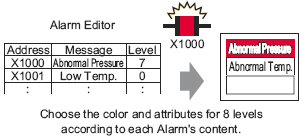
 19.10.2.5 Show History - Color Settings
19.10.2.5 Show History - Color Settings
Group
This item is displayed only when [Enable the Group feature] is selected in the [Common] tab. Set a group number to each alarm message within the range between 0 and 6096.

When the [Group Number] is "0", it will not count.
Sub Display Screen Number
When using an Alarm part for a Sub Display, select the desired Base Screen Number from 0 to 9999, or the Text File Number from 0 to 8999.
Specify the Index numbers of the play list file for playing movies.

If no Sub Display is required, enter "0". The initial setting is "0".
Addresses 1 to 8
Sets Addresses to read Alarm Message data.
The input rows become available for the addresses specified in [Number of Addresses].
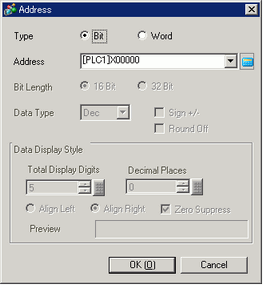
Type
Select the address type from either [Bit] or [Word].
Address
Sets read data addresses.

You can set an external device/PLC address, an internal address, a symbol variable, and a system variable for a Bit Address.
Bit Length
Choose the data bit length from [16 Bit] or [32 Bit].
Data Type
Choose the data format of the value stored in [Word Address] from [Dec], [Hex], [BCD] or [Float].
Sign +/-
Use for negative numbers. This can only be set when the [Data Type] is [Dec].
Round Off
Select whether or not fractional values will be rounded off when data is displayed. Values to the right of the decimal point will be discarded if rounding off is not selected. This setting is available when [Data Type] is [Float].
Data Display Style
Total Display Digits, Decimal Places
Specify digits for display values from 1 to 11. When selecting [Float], the range of the digits is from 1 to 17. "Total Display Digits - 1" is the maximum range for the number of digits after the decimal point. The range depends on [Bit Length] and [Data Type].
|
Bit Length |
Data Type |
Total Display Digits |
Decimal Places |
|
Setting Range |
|||
|
16 bit |
Dec |
1 to 11 |
0 to 10 |
|
Hex |
1 to 11 |
- | |
|
BCD |
1 to 11 |
0 to 10 | |
|
32 bit |
Dec |
1 to 11 |
0 to 10 |
|
Hex |
1 to 11 |
- | |
|
BCD |
1 to 11 |
0 to 10 | |
|
Float |
1 to 17 |
0 to 16 | |
Align Left/Align Right
Select the display position of a value from [Align Left] or [Align Right].
Zero Suppress
If this option is selected, leading zeros are not displayed.
For example, Number of Display Digits = 4

Preview
Displays the data image according to the settings.